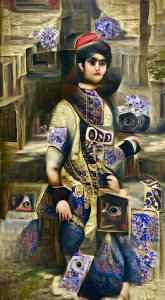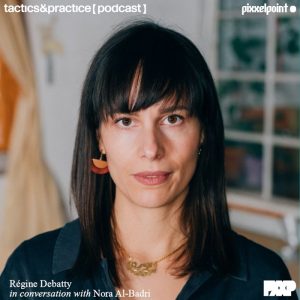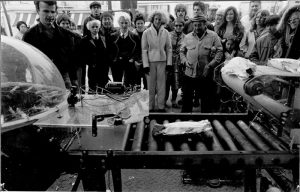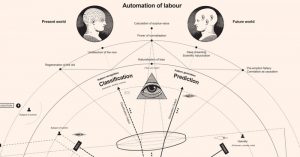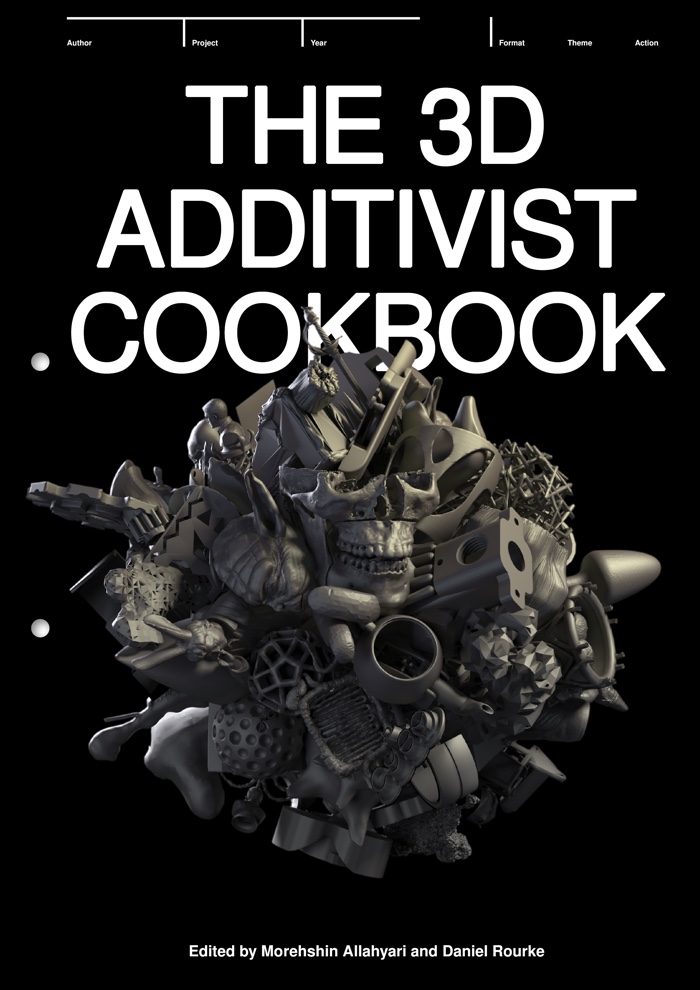
Quick post to say that:
1. If you’re in London this coming weekend, don’t miss the Digital Design Weekend 2017. It’s the 7th edition and this year’s a particularly good one with plenty of critical, intelligent and edgy works and ideas. Think Garnet Hertz‘s Disobedient Electronics: Protest, Tactical Tech, Nina Sellars, etc.
2. Artist Morehshin Allahyari and writer/artistDaniel Rourke are also part of the programme with The 3D Additivist Manifesto and The 3D Additivist Cookbook. And i’ve been asked by the lovely and sharp Irini Papadimitriou to interview them for the catalogue of the Digital Design Weekend. What they’ve done for the reflection around 3D fabrication, speculative design, and more generally digital culture is invaluable. The texts of the catalogue are online but i’m copy/pasting my intro (i’m always surprised at how flowery my prose gets when i’m asked to write ‘outside’ of my blog) and our interview below because it has images and you know i love images:
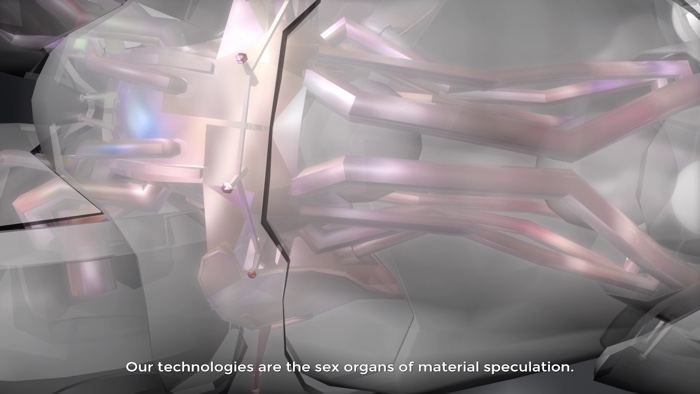
#Additivism: An interview with Morehshin Allahyari and Daniel Rourke
For its evangelists, 3D printing is going to breezily save the world one 3D printed kidney, wind turbine, honeycomb or insect snack at a time. The costs of domestic 3D printers are dwindling, the products custom-manufactured to meet our precise needs and the technology has been hailed as the most liberating and revolutionary since the steam engine.
Like with many innovations, this cheerful outlook has soon been met with warnings of copyright hurdles, high energy uses, harmful air emissions, and the realisation that the technology relies on the toxic extraction and processing of minerals and crude oil.
#additivism is the bastard of these two visions. It conjures nightmares of toxic machines churning out guns, drugs, counterfeit cash and meaningless trash ad libitum. It also take its cue from additive manufacturing technology itself and suggests that small scale, cumulative actions have the potential to bring about bigger, more complex realities.
In 2015, Morehshin Allahyari and Daniel Rourke released The 3D Additivist Manifesto and called for objects and strategies that would push the physical and conceptual boundaries of 3D printing to its most radical, dystopian and disobedient limits. Artists, designers, activists and thinkers responded with speculative or practical projects, each of them a kind of recipe for transgression and critical meditation on 3D printing and the emancipatory promises of technology. They are presented in The 3D Additivist Cookbook. Made available in 3DPDF format, it is free to download, share, remix and subvert (at additivism.org).
With it, 3D printing finally gets the counterculture movement it deserved.
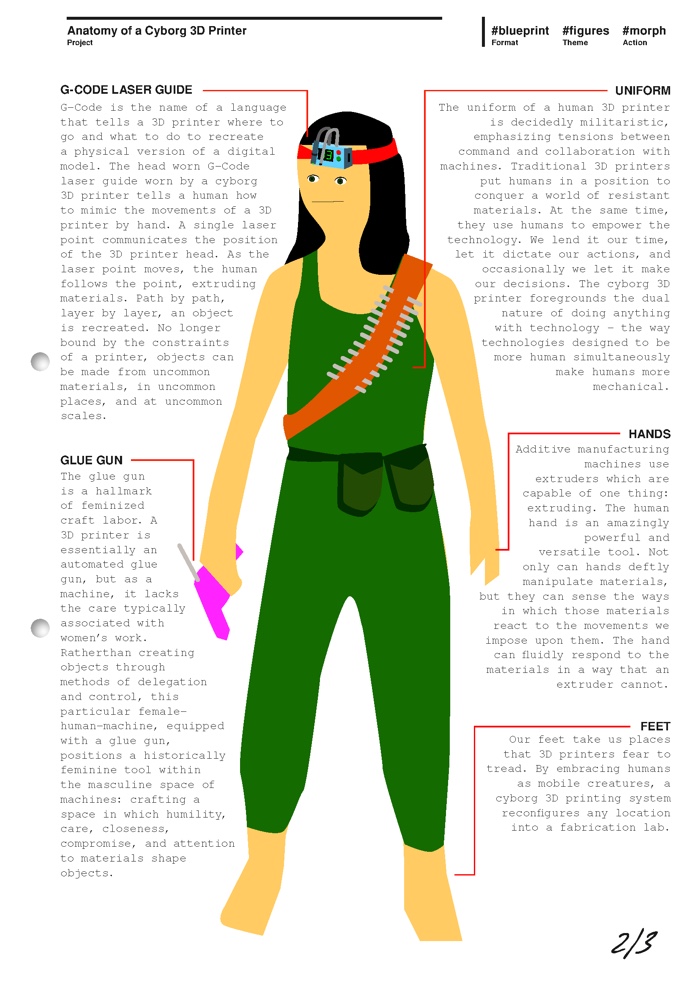
Laura Devendorf, Anatomy of a Cyborg 3D Printer. A #figure from The 3D Additivist Cookbook
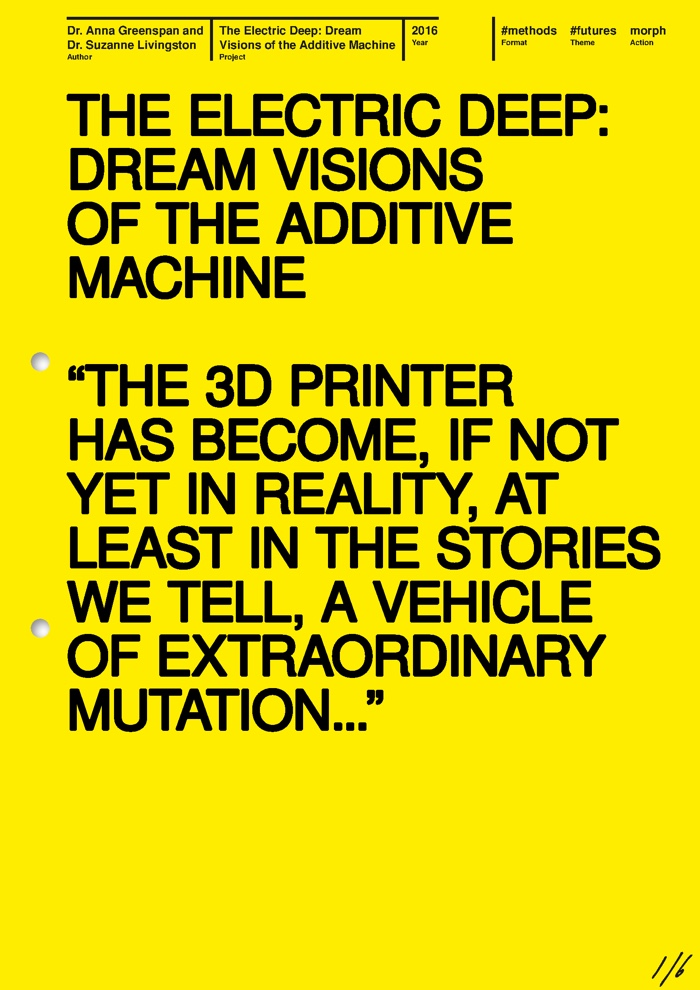
Anna Greenspan & Suzanne Livingston, The Electric Deep: Dream Visions of the Additive Machine. A #method from The 3D Additivist Cookbook
Régine Debatty: Hi Morehshin and Daniel! I like that you chose to follow the idea of ‘staying with the trouble’ and that we probably need to accept that the world is already beyond fixing. This is quite at odds with the tendency of design to imagine nicely-packaged solutions to all sorts of small and vast problems. Have you found that the idea of embracing the horror is still as radical as it was when you embarked on the project?
Morehshin Allahyari and Daniel Rourke: This notion of ‘solving’ a problem, especially in a world that feels increasingly non-fixable, is something that we have discussed and taught in many of our talks and workshops. In the world of #Additivism and our own practices as individuals, we’ve been big advocates of micro actions as ways to make something with wider reach and more critical potential. To build platforms and communities and frameworks for educating through rethinking and refiguring. And in contradiction to many of the principles of design, we are not interested or obsessed with answers and solutions. We want to expose things. Make invisible things visible. Mess things up, or at least offer mess and humour and darkness and speculation as ways to reconsider the complicated status of topics like equality, global ecology, or reproductive rights that need to be constantly re-assessed.
#Additivism is about poking at things with weird sticks and asking ever difficult, and often unpalatable questions. To take the very powers that oppress you and using their strategies and languages and aesthetics against them. Embrace the apocalypse but use its darkness to create light. That’s how we’ve been staying with the trouble.
A solution is always a solution ‘for’ some particular, universalised group. And so ‘radicality’ is a constantly shifting notion, dependent on the struggles and conflicts that impact the lives of unheard and unrecognised subjects. Over the life of our project the rise of negative political campaigns, such as Brexit and Donald Trump, signal how appeals to universals are still a powerful force. We oppose the grand narrative, and rather hope for an explosion of counter and micro narratives, for a recognition of singularities – plural – a project that by necessity must go on and on endlessly.
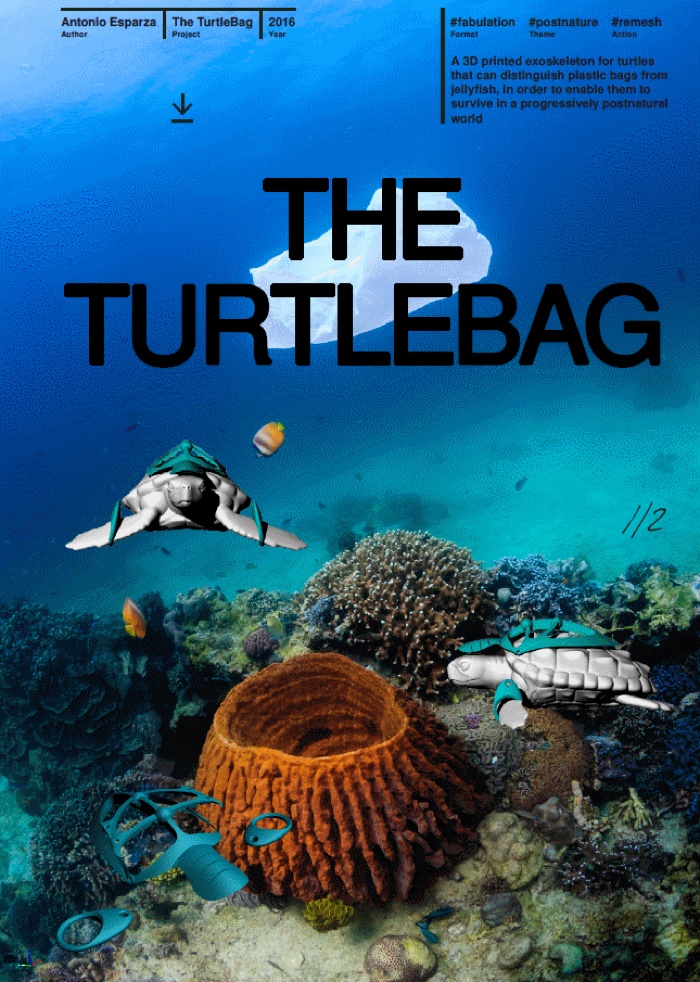
Antonio Esparza, The TurtleBag. A #fabulation from The 3D Additivist Cookbook
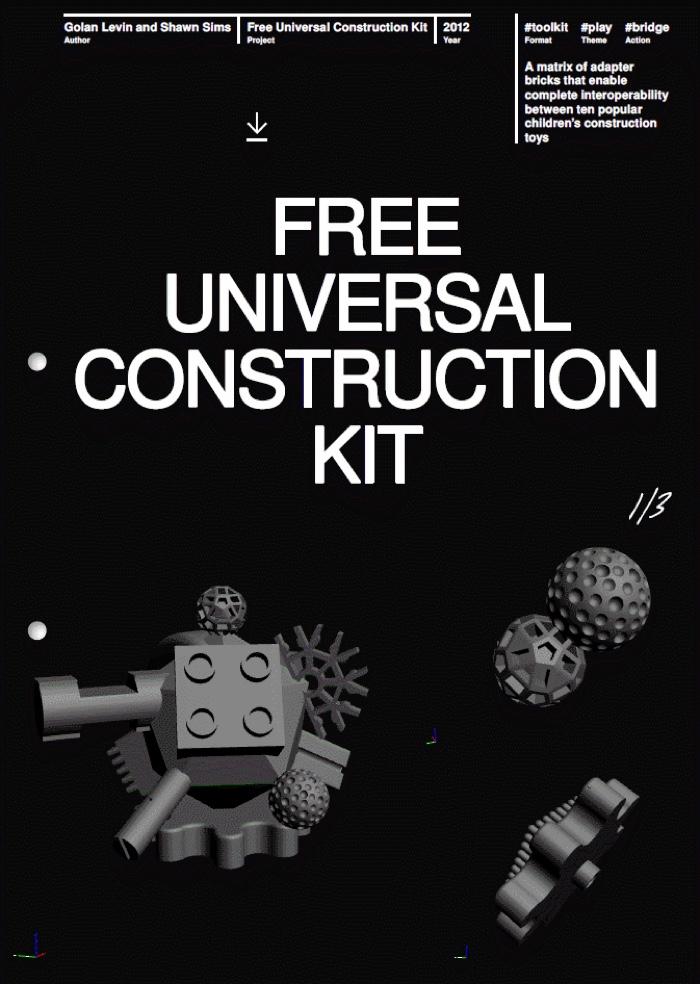
Golan Levin and Shawn Sims, The Free Universal Construction Kit. A #toolkit from The 3D Additivist Cookbook
R: Judging from the content of The 3D Additivist Cookbook, it seems that #Additivism has found echoes beyond plastic and 3D printing. Could you tell us how the dystopian and utopian dimensions of 3D printing can be applied to other disciplines, media, practices and technologies?
M&D: For us the 3D printer has always been a metaphor and point of departure to delve into and overlap others disciplines and worlds. The more we developed the project, and especially when it was the time to make selections for the Cookbook, we used #Additivism as a network of forces. Economic, social, political, material, infrastructural. The 3D printer is a machine that offers the promise of being able – one day – to make copies of itself. A radical metaphor for the capacity of life breathed into the world of inert matter. In an era of increasing interest in robots, AI, and other non human technological agents, the 3D printer is still a vibrant metaphor for the capacity of our technologies to inhabit and parasitise new spaces and realities. Who the particular subjects are who seek out and inhabit these new spaces is our concern, and this is another point at which the 3D printer becomes more than a neutral technology. #Additivism sought to wrestle control of 3D printer narratives away from the white tech males who dominate the field. So we still believe that #Additivism is a call for those on the ‘outside’ to seize control and multiply the possible spaces and worlds they inhabit from fablabs, maker-spaces, bedrooms, and laptop screens.
An Additivist is someone who is interested in the potential of technology to leverage small, incremental actions to potentially planetary significance. No 3D printer is required.
For a large central section of The 3D Additivist Cookbook we commissioned two artist groups – A Parede and Browntourage – to curate a series of ‘Additivist’ works. The works from artists of Middle Eastern, South American and other non-western heritages spiral around queer, feminist and decolonialist narratives. We are really proud of that section of The Cookbook in particular, because it often calls our entire project into question. Challenging dominant narratives is crucial to maintaining plurality. The 3D Additivist Manifesto asked to be contradicted and re-envisioned. Every work in the resulting Cookbook is therefore a seed for generating worlds and actions that even – and perhaps especially – its original designers did not envisage.
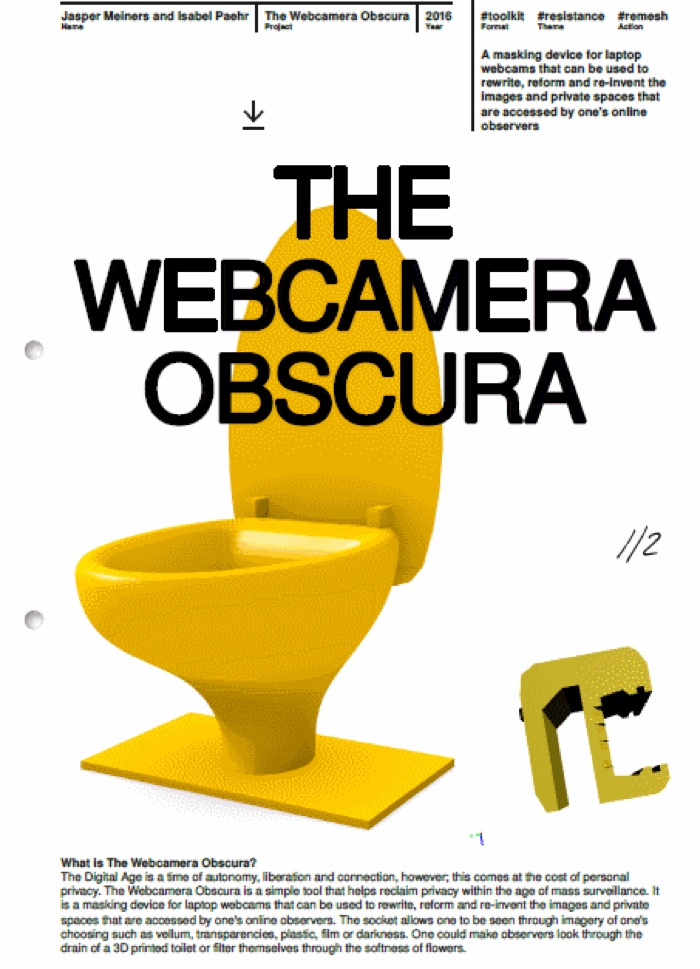
Jasper Meiners and Isabel Paehr, The Webcamera Obscura. A #toolkit from The 3D Additivist Cookbook
R: Few things make me happier than seeing provocative design or art ideas spread outside of the usual creative circles of galleries and festivals. How can someone who’s neither an artist nor a designer engage with the #Additivist ideas and introduce small, concrete forms of radicality into their life?
M &D: That’s awesome to hear! We share that happiness with you. So much of what we wanted to build was accessibility, education and activation (daily small actions). We urge people to do the same, and hope #Additivism inspires them. How can your particular skill or knowledge be translated into frameworks for educating and including others? What story or counter narrative do you have to bring to the world? The Cookbook’s most radical feature – we hope – is its accessibility and openness (download it for free now and see). But we are far more excited about the projects that are not contained in it, that still have to be imagined. That’s a daily radical proposition. What worlds have yet to be envisioned? We can only answer that together. Jump in.
A lot of action-based projects in the Cookbook can be realised by anyone with any kind of background, as long as they can download the objects from our website and take it to a fablab for a cheap 3D print. For example, a project by Isabel Paehr and Jasper Meiners called ‘Webcam Obscura’ which is a simple playful anti-surveillance tool for laptops. In addition, a good portion of the Cookbook includes essays, interviews, and stories (mostly science fiction) brought together to encourage Additivist way of thinking. Out of the many many workshops we have delivered we’ve only ever used a 3D printer once. Many projects in the Cookbook do their critical work without ever needing to be 3D printed. Kyle McDonald’s Liberator Variations, for instance, questions the status of the now infamous 3D printable ‘Liberator’ gun, but is also a playful tutorial and poetic homage to 3D rendering software. Many of the most ‘radical’ Additivist Cookbook projects are also the simplest. We hope the Cookbook encourages people to play, experiment and not be afraid to make mistakes. That’s the best way to learn, and it’s fundamental to the practices of art and design. We all start as amateurs. Some of us try really hard to stay that way.
R: Because the place of women in the tech world is still one we have to fight for, do you think that there is a place for feminism in #Additivism?
M&D: Yes of course or we wouldn’t do it at all. It’s actually quite interesting to walk into Fablabs anywhere in the world and see so many women standing next to machines 3D printing or laser cutting objects. It’s something we’ve been counting and paying attention to. But in addition to quantity and numbers, so much of #Additivism is about ‘the female future’ we want to participate in building. The feminism we are interested in is a philosophy of more than women, it is a philosophy of non male, non cis, non white. All those people who have at one stage or another been considered less than human by the social systems that oppress them.
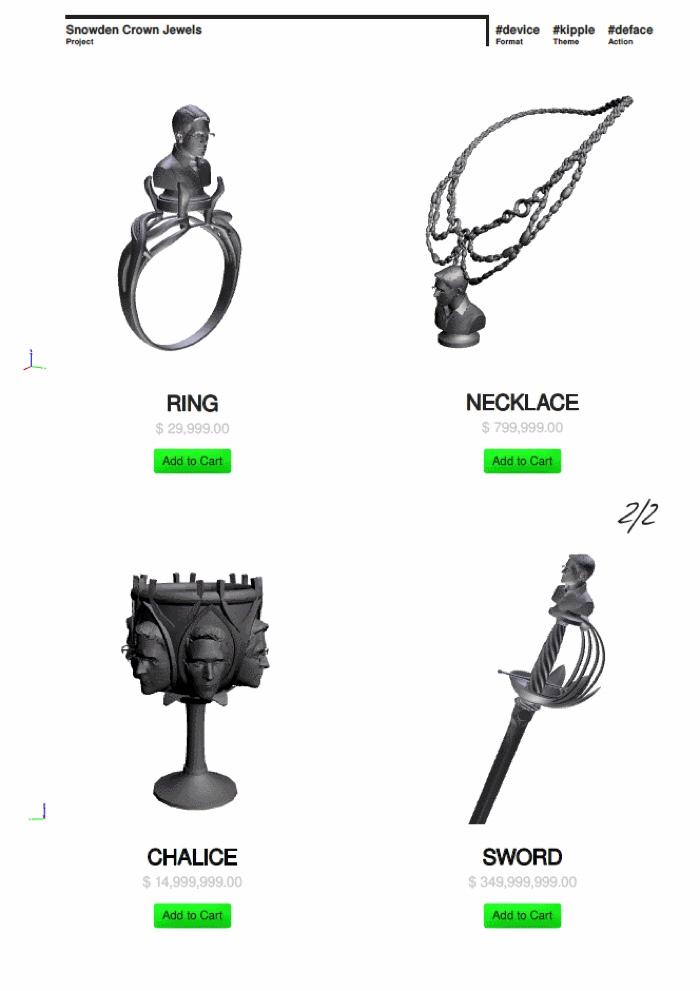
Zach Rispoli, Snowden Crown Jewels. A #device from The 3D Additivist Cookbook
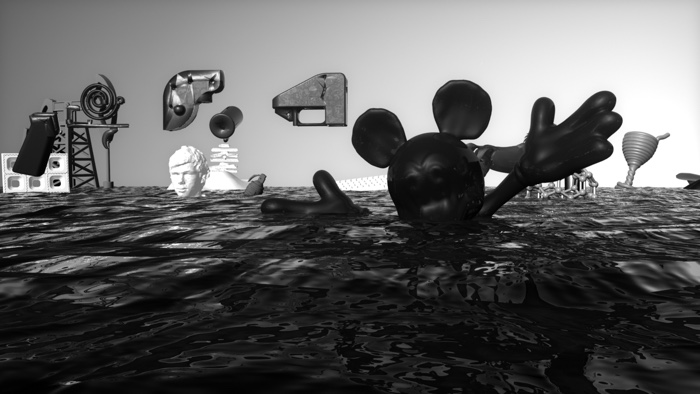
R: #Additivism brings to light an apocalyptic vision of the world. Yet, there is a fair amount of irony and humour in The 3D Additivist Cookbook. How do you reconcile horror with humour?
M&D: Between the two of us we have often talked about (jokingly and for real) being Positive Nihilists. So much of that is about our personalities and how we also perhaps handle the dark world we live in…lol. Do we really have to reconcile humour? If humour is a radical act in itself then it need not be considered as somehow the opposite of dystopia/darkness/apocalyptic visions.
Laughter is a shared bodily sound that carries across a group to show that the threat has passed. One human thinks they see a snake in the grass and call out an alarm, but then they quickly realise it is just a stick, and begin to laugh, and their companions laugh at their mistake. Humour today might play a similar role in light of the global problems we face. #Additivism is full of distractions and counter propositions, pointing to a perceived threat, but showing that the real concern lies elsewhere, at a different scale. Humour is significant in that act. Shared mind shifting. Reflective counter-actions and realities. Embracing the horror together.
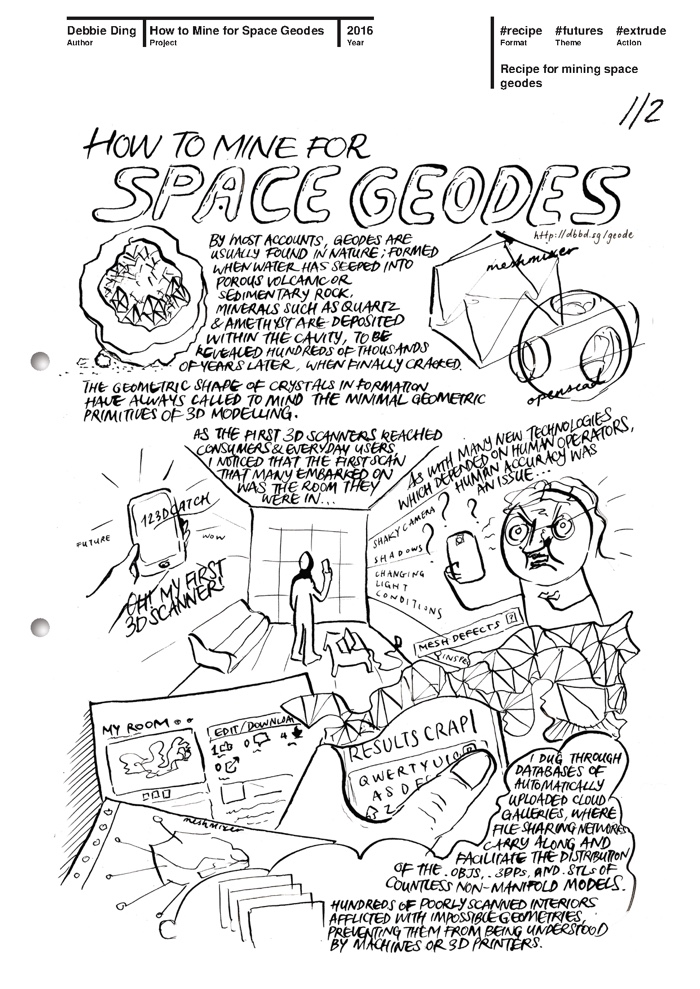
Debbie Ding, How to Mine for Space Geodes. A #recipe from The 3D Additivist Cookbook
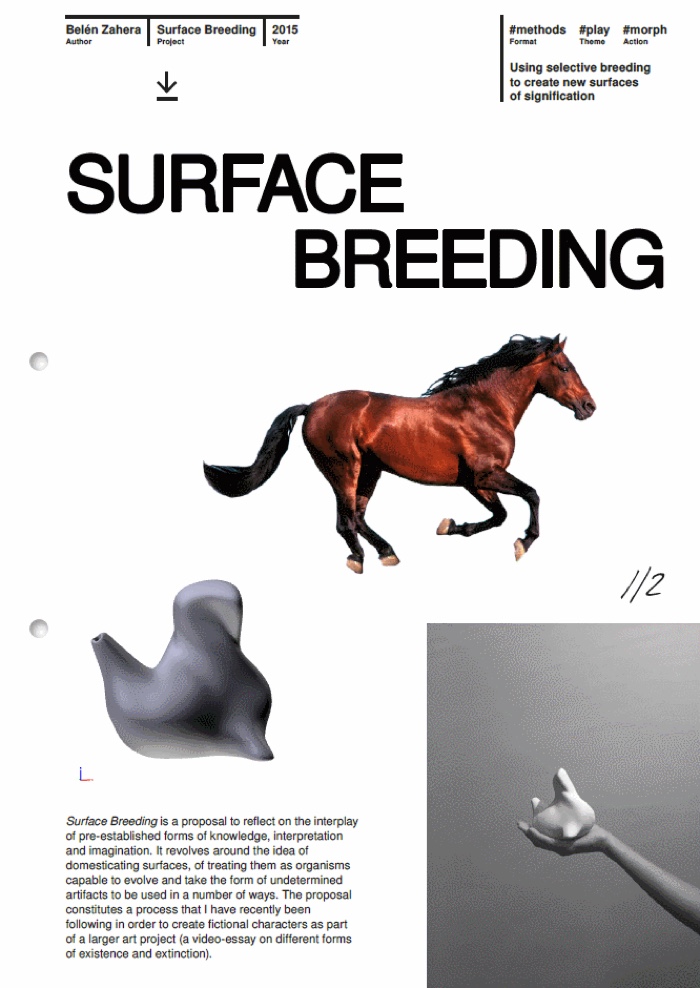
Belén Zahera, Surface Breeding. A #method from The 3D Additivist Cookbook
The Digital Design Weekend is taking place at the V&A in London on Saturday 23 & Sunday 24 September, 10:30-17:00. It coincides with the London Design Festival at the V&A. All events are free.
Previously: The 3D Additivist Manifesto + Cookbook.

